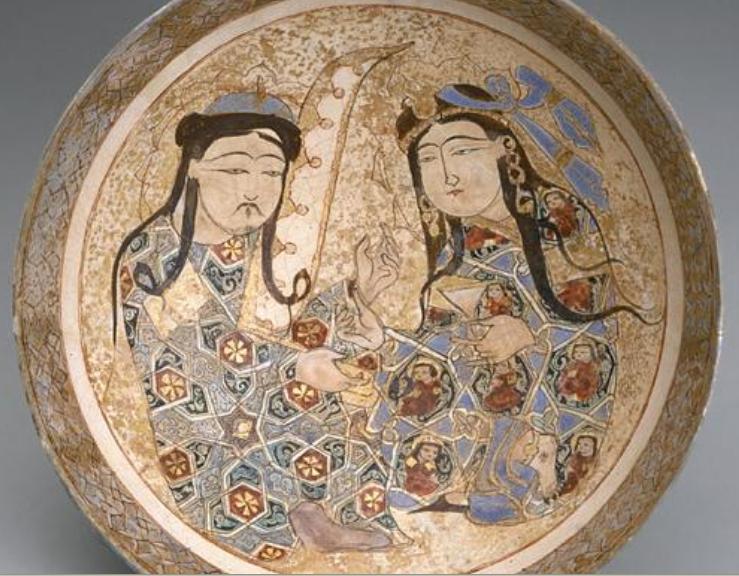
Create an Amazon Business Account
Saljuq Bowl with Harpist, late 12th-early 13th century.

A larger image of this Saljuq Bowl with Harpist, late 12th-early 13th century. Freer Gallery of Art, Washington DC, F1938.12.


Bowl
Clay: sandy, white.
Glaze: opaque, cream-colored, crazed; lustreless blue glaze on the base.
Decoration: painted in overglaze enamels and gold. Inscription.
HISTORICAL PERIOD: Saljuq period, Late 12th-early 13th
MEDIUM: Stone-paste body painted over glaze with enamel (mina'i)
DIMENSIONS: H x Diam: 8.8 x 23 cm (3 7/16 x 9 1/16 in)
GEOGRAPHY: Iran
CREDIT LINE: Purchase — Charles Lang Freer Endowment
ACCESSION NUMBER: F1938.12
PROVENANCE:
To 1938: Dikran G. Kelekian (1868-1951), Cairo, Egypt, Paris, France, and New York to 1938
From 1938: Freer Gallery of Art, purchased from Dikran G. Kelekian, New York in 1938
Source: Freer Gallery of Art, Washington DC
Referenced as plate 41 in E. Atıl, Ceramics from the World of Islam, Washington, D.C., 1973.
41 Bowl with flaring sides, straight rim and low foot 38.12
Paste: off-white
Glaze: opaque white
Decoration: overglaze painted in polychrome colors and gold
Height: 8.8 cm. (3 1/2 in.); diameter: 23.0 cm. (9 1/16 in.)
Iran, Seljuk period, late 12th-early 13th century
This bowl of exceptionally refined execution depicts a royal couple placed against a plain gold ground which has partially deteriorated. Both figures wear highly ornate clothes and have flaming haloes around their heads. The figure on the right is a lady of high rank as suggested by her jeweled headdress consisting of a diadem with a raised palmette in the center, attached to her head by fluttering ribbons. She wears long looped earrings and an anklet, and holds a stem-cup in one hand while gesturing towards her companion with the other. Her elaborate outfit is composed of panels depicting seated figures.
The male figure, who plays a lyre, is attired in an embroidered garment adorned with arabesques and stars. On his head is a cap with a high portion in the center, often interpreted as a jeweled ornament worn on the turbans of princes. A wide blue band adorned with golden diamonds encircles the rim.
The exterior has a blue band with alternating stylized leaves and blossoms. Below this band are six large arabesques interspersed with small cartouches. The foot, as well as the base, reveal a blue glaze.
Due to the exquisite drawing of the figures (particularly the faces and the hands) and the remarkable details on the garments, this piece is often classified under "first royal style" and attributed to Kashan (Pope, Survey, pl. 652). The theme of a seated royal couple occurs on several contemporary pieces, executed in minai, luster, or black-painted and blue-glazed wares (e.g.. No. 42; Pope, Survey, pls. 651-53; Lane, Early Islamic Pottery, pls. 58B, 68A and 84A; Bahrami, pls. XXXVIII, LXXII and LXXIII which is dated 1215). However, this is the only example in which the female figure outranks the male who is clearly entertaining the "queen."
M. Bahrami, Recherches sur les carreaux de revêtement lustré dans la céramique persane du XIIIe au XVe siècle (étoiles et croix), Paris, 1937.
A. Lane, Early Islamic Pottery, London, 1947; 5th ed., London, 1965.
A. U. Pope (editor). A Survey of Persian Art, 1938.